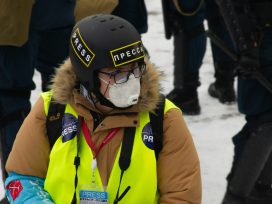Metaverse wars
War becomes the twin of communication: the development of media has not only changed how warfare is reported, but also how it’s fought. The working rule of the warriors is to spread strategic information and disinformation at every instant. And media workers are culpable too, for abusing the genre of breaking news reporting to magnetise audiences and advertisers, doing it at a great symbolic cost.
During recent months, scores of reporters and commentators have expressed their surprise at the ‘return’ of war and the renewed chances of a Third World War centred in Ukraine. ‘Europe woke up to a major war on Thursday after Russian President Vladimir Putin launched a violent, multipronged invasion of Ukraine, the democracy that sits between NATO countries and Russia’, wrote CNN’s Zachary B. Wolf just hours after the Russian army first swooped on Ukraine.
Much the same surprise was expressed by Germany’s most prominent public intellectual Jürgen Habermas. ‘77 years after the end of the Second World War and 33 years after the end of a fragile peace maintained only through a delicate balance of terror’, he wrote in the Süddeutsche Zeitung, ‘disturbing images of war have returned – right outside our door and unleashed arbitrarily by Russia.’
I have found such remarks quite surprising myself, if only because in my lifetime war has been a constant companion. I was born into an age of unending war. My uncle was tortured and starved to death in a Japanese concentration camp on the island of Ambon. Images of death and starvation in Biafra first reached me as a teenager through the newspapers of the late 1960s. During my first week of university, I was conscripted to fight in Vietnam. I refused.
Famously called the first television war by Marshall McLuhan, that brush with war sparked family disagreements and taught me my earliest political lessons. I had a close-range taste of gunfire when visiting Lebanon just as that beautiful country was plunging into a brutal conflict that proved that no war is ever civil. I saw with my own eyes how war generates vicious circles of hatred and leaves a whole country in utter ruins, with only victims and no victors.
War has been unending for me in other ways. The highlights – the low points – include turning my back publicly on the hoisting of Union Jacks during the Malvinas War. At the end of the 1970s, in a crowded London club, watching (if I remember correctly) the Clash pump the lyrics ‘Hate and War! The Only Thing We Got Today!’ Angrily thumping a presenter’s table during a December 1991 Sky Television News interview about the bombardment of Dubrovnik, a city where I had taught for several years before the outbreak of a vile war that scarred most of my Yugoslav friends for life.
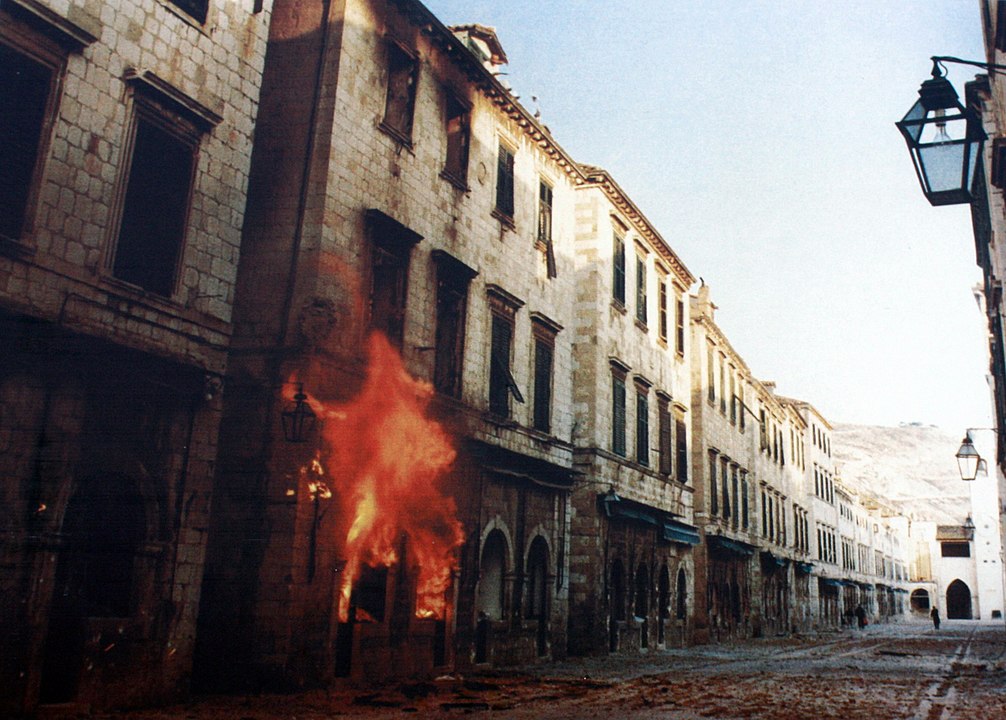
Fire in the old town during the siege of Dubrovnik, photographed in 1991. Image from the Museum of the Homeland war in Dubrovnik, via Wikimedia Commons.
I later wrote and presented a BBC radio documentary on the secret nuclear testing that took place from the mid-1950s in my native South Australia. It featured survivors’ stories of the reckless experiments that vomited plumes of contamination across the desert and left behind a vast zone of deadly nuclear rubbish that claimed unknown numbers of lives, including uprooted indigenous people and onsite workers – among them my father.
I was moved to write and publish essays and books about violence, the history of war and democracy, and the new wars against drug lords, terrorists, guerrillas and other non-state actors. Through the media of television, radio and newspapers I have witnessed what feels like a permanent procession of wars, in Mozambique, Mali and Somalia, in Palestine, Iraq, Afghanistan and Syria, and in Myanmar and Kashmir.
And now there’s global media coverage of the horror, carnage and day-and-night destruction raining down on the people of Ukraine.
From donkeys to smartphones: history matters
When trying to make sense of these wars of our age and how journalism narrates their effects to wider publics, history really matters. When we are ignorant of the past, we invariably misunderstand the present; awareness of the past helps us grasp the measure of things. We come to realise, for instance, the great military and political significance of newly invented weapons (the sword, Greek fire, crossbow, the machine gun and chemical weapons) and changing modes of making war.
We come to understand how, during the second half of the 19th century, war fought by cavalry and close infantry formations was rendered obsolete by rifles, steel cannon and bursting shells; and we are forced to wonder whether nuclear weapons and the so-called ‘balance of terror’ will permanently protect our planet from human self-destruction.
We are led as well to see that small developments can have much larger historical consequences. Think of the mid-19th century invention of the profession of war reporting and the role of such figures as William Russell, a fellow Irishman who reportedly liked to drink hard to calm his nerves when on missions to file remarkable dispatches for The Times of London from Crimea and the bloody fields of the Indian Rebellion, the American Civil War and the early 1870s Franco-Prussian War.
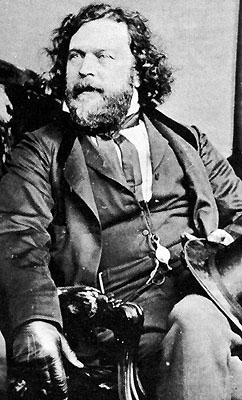
William Howard Russel (1821 – 1907) potographed by Matthew Benjamin Brady around 1860. Image via Wikimedia Commons.
But history also matters in another way. It helps us recall what Harold Innis and Marshall McLuhan of the Toronto School of journalism and media have taught us: different historical modes of communication structure differently people’s bodily senses, patterns of cognition, mental horizons and daily experiences of the world. Media of communication aren’t to be understood as ‘neutral’ channels that convey ‘information’.
Think instead of things this way: in times defined by orality, writing and messages spread by horses, donkeys and foot runners. In these conditions, war’s battles, sieges, victories and losses were reported only after the fact. War did not know media coverage. News from battle fronts was conveyed at a snail’s pace, reported ex post in poems, plays, speeches and books, some of which later became classics.
Thucydides’ early 4th century BCE History of the Peloponnesian War is an example, remembered for its observation that in war ‘the strong do what they can and the weak suffer what they must’. Sun Tzu’s famous Art of War, written in the previous century, is similarly remembered for its comparison of war fighting with flowing water and proverbs such as ‘supreme excellence consists of breaking the enemy’s resistance without fighting’.
The Prussian general Carl von Clausewitz’s Vom Kriege, published posthumously in 1832, fits this pattern. Emphasising that in an age of popular mobilisation war is a continuation of politics using other means, it’s a classic that belongs to the era marked by the absence of war reporting and the slow-paced delivery of news.
At the time of the 1815 Battle of Waterloo, for instance, there were 56 newspapers published in London, but not one of them arranged in advance to relay news from the battlefront. Carried by horses and a rowboat, news of the historic defeat of Bonaparte by Wellington’s army less than 350 kilometres from London took 3 days to reach there – and 7 months to reach Sydney by sailing ship.
As printing presses first rolled out daily newspapers whose stories were spread with the help of coal-fired steamships, followed by the telegraph and early radio broadcasting, news of war underwent electrification. Time-space barriers shrunk rapidly, but they never reached point zero.
World War I is often said to be the first military conflict shaped by electrified mass communications. Electrification indeed enabled quick reportage and the mobilisation of whole populations in support of a war that was supposed to end all wars… A war which, as we know, instead ended in the near destruction of parliamentary democracy, the spread of totalitarianism and two catastrophic global wars that robbed more than a hundred million soldiers and civilians of their lives.
But new research casts doubt on that old Eurocentric story that 1914 – 1918 was a historic tipping point in media reports of war. It happened earlier, and elsewhere. The beginnings of mass broadcasting of war are in fact traceable to the Russo-Japanese War of 1904-1905.
That conflict was not only the first modern war that resulted in victory for an Asian power at the expense of a European-based army. It was the moment when, for the first time, war journalists such as Lionel James, who reported for the New York Times and the Times of London, experimented with radio technology. To overcome the old problem of interference with telegraphed messages by operators at relay stations – reports were often censored or their contents falsified – he provided newspapers with news of battles from an offshore boat equipped with a jury-rigged radio transmitter mast tower.

American journalist Ernie Pyle reported from Europe, Africa and the Pacific during World War II. He was among the first journalists to join soldiers at the front and report things from the standpoint of the regular ‘grunt’. In April 1945, he was killed by Japanese machine-gun fire during the Battle of Okinawa. His statue is in front of Franklin Hall at Indiana University. Image via Wikimedia Commons.
Satellite broadcasting, followed by the digital integration of newspapers, radio and television and the multiplication of gatekeeper and gate watcher platforms, have since changed everything in war reporting. In my lifetime, war stories have become instantly available at every point on our planet.
War has become highly visible and more palpable. It has drawn closer to us.
Remember the key point: in any age, in matters of war, the reigning forces and relations of communication get to shape and structure what can be reported, how war is reported, why this or that war is significant, and how it ‘feels’ to victims and witnesses alike. The medium shapes the sent messages – and the public reception of those messages.
Marshall McLuhan’s War and Peace in the Global Village (1968) famously noted the historic significance of journalists for the first time using portable, battery-powered video tape (‘portopac’) cameras and filing their filmed dispatches by jet aircraft overnight to supply television outlets news for the next morning’s broadcasts at home. ‘We are now in the midst of our first television war’, he wrote. ‘The television war has meant the end of the dichotomy between civilian and military. The public is now participant in every phase of the war, and the main actions of the war are now being fought in the American home itself.’
CNN’s non-stop 1991 Gulf War coverage took things further. It was among the watershed moments in the contemporary history of war and media. It signalled the end of space-time lags, the first truly global distribution in real time, the most thorough mediation of war ever. It paved the way for a string of novelties, even making possible, as in Mogadishu in Somalia, live reportage that featured journalists armed with lights, cameras and microphones bizarrely greeting the 1992 beach landing of US marines in Operation Restore Hope.
The dawn of the metaverse wars
The digitisation of war reporting is today culminating in what a young Chinese scholar Shi Zhan first called ‘metaverse war’. The phrase must be handled with caution.
Metaverse is a hip fuzzword. Drawn from Neal Stephenson’s science fiction novel Snow Crash, it’s a portmanteau term used to refer to digitally networked 3D technologies that draw socially connected users into what seem to be ‘realistic’ virtual worlds. Used carefully, it’s a good word to describe the way war, for the first time, is coming to have a digitised, gamified, augmented reality quality.
Consider these metaverse features of the Ukraine War. Each evening, a president of a war-ravaged country who was previously a comedian and television actor, the star of a series called Servant of the People, delivers moral appeals for military help to global audiences.
The president’s staged performances are carefully tailored to their target audiences. What is said to the members of the Knesset (Russia is preparing a ‘final solution’ for Ukraine) differs in tone and substance from what is told by video link to parliaments in Athens (‘Ukraine is one of the Orthodox countries that was Christianised by the Greeks’) and in Ottawa (where he received several standing ovations during a speech laced with references to Vancouver, the CN Tower in Toronto and other cities and landmarks).
Skilled and seasoned television and public relations and marketing professionals assist the dramaturgy. Their job is to narrate the progress of the war and arouse the indignation of audiences by using to the maximum available digital networks.
Metaverse wars draw together the online and offline worlds. War room briefings, smoke-filled battlegrounds, images of fighter jets, tanks and troops, wrecked buildings, burning fields and frightened civilians: images, sounds and written stories of all these horrors of war are combined and relayed across vast distances in real time. The messages are received and circulated across a plethora of platforms. Not all of them are state-run or profit-seeking corporate media firms.
War becomes a gamified social media performance. There are cyberattacks, organised hacks, the spreading of malware, takedowns and defacement of sites. Shrouded in hyper-secrecy, AI-powered drones – drone swarms and nano drones, known in the trade as ‘remotely piloted aerial systems’ – kill anonymously, without warning, from great heights. Volunteers join cyber-armies on Telegram Messenger.
Information is copied, posted and re-posted, mashed up, liked and disliked. Regional governors and mayors post news on Facebook and Twitter. Users are drawn into the performance. Whole armies do the same: in major reforms of recent years, the Ukrainian army dispensed with combat units larger than battalions. Its fighting structures became flatter, its command and intelligence operations more tightly connected digitally. It now deploys digitally guided, state-of-the-art Stinger and Javelin missiles and Saab’s NLAW anti-tank weapons.
For their part, civilians feed on-the-spot, battlefield intelligence to the armed forces; and citizens broadcast their own misfortunes, live, to the wider world. Vloggers – including foreigners like Jixian Wang in Odesa –provide running commentaries. Roving independent reporters circulate reports from the ground. The grisly images and graphic sounds they gather are picked up by Al Jazeera, the Los Angeles Times and other mainstream media platforms. The local draws global audiences into the 3D virtual reality of war.
Censorship
In the age of metaverse wars, the digitisation of war reporting is complicating the lives of states and armies. It should come as no surprise, since arbitrary power loves secrecy, that they do all they can to block and airbrush the images, sounds and stories they find threatening. Russian-style despotisms and their state-controlled news platforms such as Vremiya specialise in crushing and criminalising their opponents’ messages. Twitter is throttled; Facebook access is subjected to slowdowns.
But there are no angels in metaverse wars. Video reports of Ukrainian soldiers executing captured Russian soldiers are now hard to find on the Internet. Exact information about the numbers of Ukrainian soldiers daily killed and wounded in action is usually unavailable. Missing too is the documentation needed to confirm or counter the suspicion that the Mariupol theatre bombing was the dirty work of the Azov Battalion, not the Russian army.
It’s an old pattern. We now live in media-saturated societies, but when it comes to censorship, some things haven’t changed. Ever since the 19th-century advent of war reporting, states that prosecute war do everything they can to ensure that truth is the first and nuance the second casualty of war.
War against media is the twin of mediated war
The Russo-Japanese war of 1904-1905 was again a watershed. That was the moment when a government first cracked down systematically on European and American journalists, preventing them from venturing anywhere near the front lines and instead grounding them in Tokyo, where they were entertained with lavish dinners, theatre performances and island tours. Since then, states’ techniques of control have grown more sophisticated.
Consider the case of the United States. A republic proud of its commitment to the First Amendment, successive governments have until today done everything to prevent journalists from sticking their noses into military affairs. When the United States entered the First World War, government moved to control and censor radio communications and photographs. Journalists were kept away from the front.
In 1917 and 1918, Woodrow Wilson and the Congress passed the Espionage and Sedition Acts, making it illegal to profane the flag or publish material considered ‘disloyal, profane, scurrilous or abusive’. 75 newspapers had their mailing privileges withdrawn or were forced to soften their editorial opposition to war.
World War Two saw the creation of a military Office of Censorship. It obliged journalists who wanted access to apply for credentials from the government, which obviously meant they had to toe the government’s military line. Stories about the creation of the atomic bomb were blanked until after World War Two had come to an end.
The Vietnam War saw the establishment of a Joint US Public Affairs Office which staged daily press conferences to manage the narrative of a war that was eventually lost, in part because of tough media reportage.
Not to be overlooked are the moments when the United States armed forces launch war on the means of communication of their targeted enemy. The First Amendment then means little or nothing, as it did during the 2003 invasion of Baghdad. The Secretary of Defense Donald Rumsfeld personally summoned Al Jazeera’s top staff to Washington and during a frosty meeting that he terminated after just several minutes (I was reliably told by Wadah Khanfar, at the time the channel’s Director-General) hinted at a military attack on its Doha headquarters.
In Baghdad, United States forces later bombed Al Jazeera and Abu Dhabi TV; and, in a well-known incident, shelled the Palestine Hotel, the main residence of un-embedded journalists, two of whom, reporters from Ukraine and Spain, were killed during the attack.
Spectacles
In the age of metaverse wars, war is not just a stage on which censorship rules supreme. In the last century broadcasting media were used for the first time to beautify war, as the German literary critic Walter Benjamin pointed out. In the age of mechanical reproduction, he commented, war is represented through ‘illusion-promoting spectacles’ and ‘aesthetic pleasure’. Fascism was the prime mover of this aestheticization of war. Communism responds, he concluded, by ‘politicizing art’.
Benjamin was right about fascism – recall the films of Leni Riefenstahl and the Nazis’ 1944 documentary ‘Beautiful Theresienstadt: the Führer Gives Jews a City’. He wasn’t right about communism though (that’s a long and sordid story), or the capitalist democracies that followed.
In the age of metaverse wars, elected governments and their armed forces, with the help of loyal journalists and state-of-the-art tools of communication, transform war into multi-media entertainment.
War becomes the twin of communication.
Media platforms function as interpellators, mobilisers, seducers, peddlers of euphemism, trickery, lies and distortion, agents of public persuasion and gaslighting. For their part, armies and governments use these platforms to project and manage sophisticated media narratives designed to win public support for war.
The working rule of the warriors is to spread strategic information and disinformation at every instant, using every available means. ‘The war is in words’, wrote James Joyce in Finnegans Wake (1939). The French cultural critic Paul Virilio replied: ‘War is cinema, and cinema is war’ (1989).
Nowadays, war comes wrapped in networked sounds, images and texts as well. Military operations come wrapped in publicity designed and handled by armed forces public relations professionals. Commanding officers are trained in the arts of avoiding bad publicity. Statements, reports and press kits are provided to journalists. Keywords and phrases such as cruel, odious, autocrat, weapons of mass destruction, victory and democracy are daily mantras.
George Orwell warned against war hawk leaders who twist syntax and words and ‘spray forth the correct opinion as automatically as a machine gun spraying bullets’. That’s what happens in metaverse wars.
There is war on the language of war, new forms of newspeak in which we hear of ‘surgical strikes’, ‘smart weapons’, ‘collateral damage’ and ‘special operations’. The point is to turn war into a spectacle, a stage performance directed by the military.
There are daily press conferences, where it is affirmed again and again that there is no censorship beyond what is necessary for military victory and the safety of the troops. There are calculated morale boosts and good news from the front. A special place is reserved for men and women of bravery, legends and heroes, some of them unknown soldiers who have laid down their lives or, like a combat pilot known as the ‘Ghost of Kyiv’, said to have scaled the peaks of impossibility by singlehandedly downing dozens of enemy planes (raised eyebrows later forced the Ukraine Air Force Command to retract the hype and to urge Ukrainians ‘NOT to neglect the basic rules of information hygiene’).
At every moment, the goal is to disparage the adversary, peddle the conviction that this is a just war, deny that things are going wrong, publish instant denials, bathe bad news in silence.
Silences
Among the weirdest features of today’s metaverse wars is the way mainstream journalism produces pockets of invisible silence within the otherwise intense media coverage of military conflicts. Few mainstream journalists bother to investigate how war is a maker of junk, a poisoner of fields, farms and forests, a great destroyer of our planetary ecosystems. They rarely sink their teeth into the political economy of metaverse wars. Thumbnail coverage of the most anodyne and superficial kind is their speciality.
‘Several NATO countries are now supplying Ukraine with heavier weapons, to enable its army to push back against Russia’s army’, reports BBC News (5 May 2022). The next day, The New York Times adds: ‘Britain will offer an extra 1.3 billion pounds (about $1.6 billion) in military support and aid to Ukraine’.
It seems not to occur to journalists who write such lines that the words ‘offering’ and ‘supplying’ are euphemisms for the ‘selling’ of weapons of mass destruction; or that their reports bolster public silence about state-backed corporations like Moscow’s Rostec, or BAE Systems, Europe’s largest arms contractor, or Raytheon, the world’s biggest guided-missile producer, or the global giant of profit-seeking giants, the arms manufacturer Lockheed Martin.
The most deafening media silence is surely manifested in the dissimulation of death. The obvious must be said, and repeated: war is death’s feast. War racks and ruins lives. It kills. Its murders scramble minds, smash dreams, break hearts, poison decency and wreck goodness. Those who survive war live permanently with war in their guts.
When war begins, the devil opens hell, says an old English proverb. The Low Countries painters Hieronymus Bosch and Pieter Bruegel knew that five centuries ago. Their hellscapes of tortured bodies, background smoke and explosions, and bodies piled high amidst tangles of rubble captured something of the realities of war in the age of the waning Middle Ages.
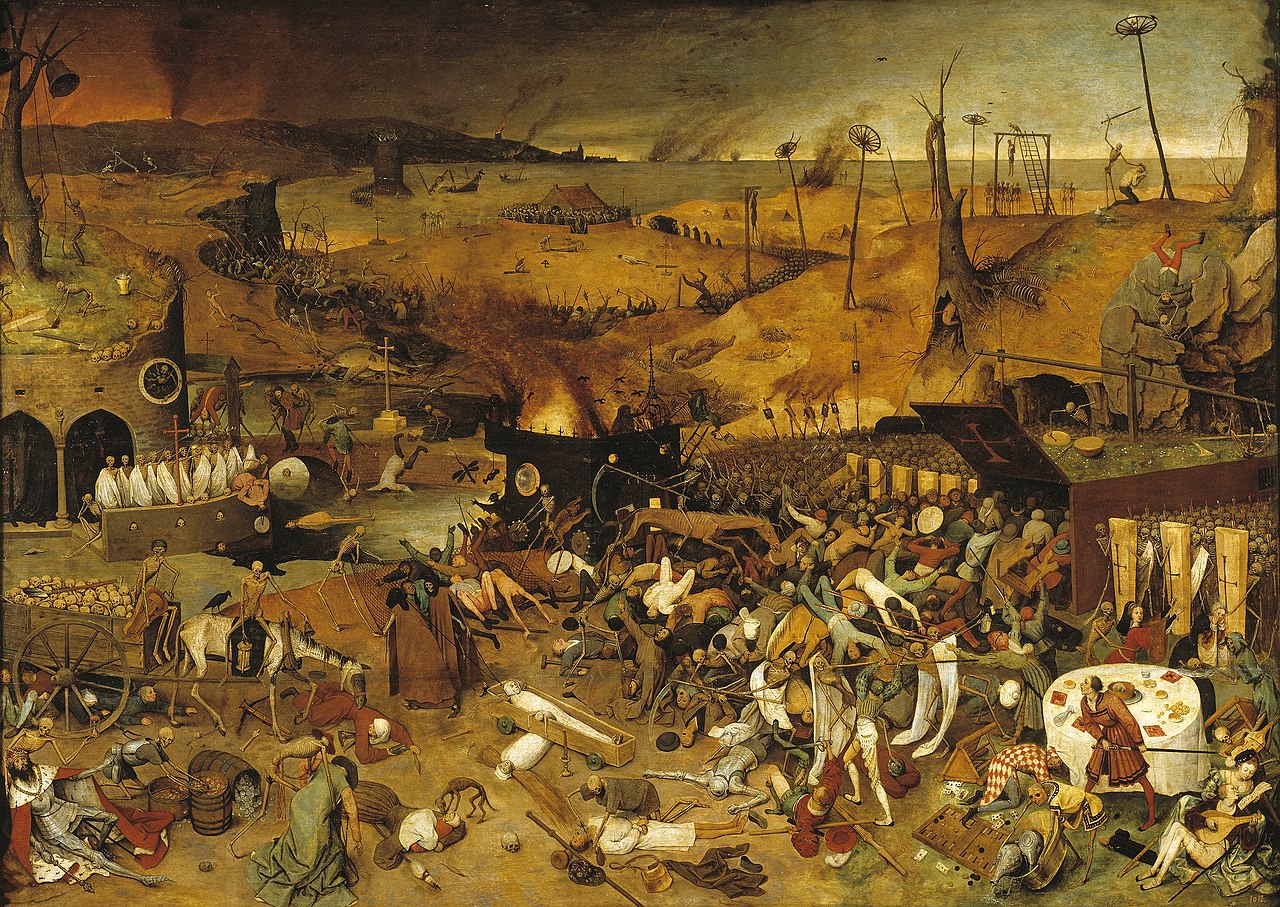
Pieter Breugel the Elder, ‘The Triumph of Death’ (oil panel, around 1562, exhibited in the Museo del Pardo Madrid). Image via Wikimedia Commons.
In the era of metaverse wars, by contrast, such imagery is conspicuous by its absence.
In its study of the first week of reportage of the 2003 American invasion of Iraq, the Washington-based Project for Excellence in Journalism reported that in more than 40 hours of material there were no images of people wounded or killed by gunfire. During the weeks that followed, public awareness of battlefield fatalities sharply declined, thanks to United States government prohibitions on journalists filming coffins of dead American soldiers. Few wonder that for his role in decoding and circulating the collateral murder video tapes, Julian Assange is now suffering permanent detention without trial.
Such dirty details make exaggeration seem appropriate: in the era of metaverse wars, warfare has become bloodless. There is savagery no more. It is as if the high-intensity mediation of war requires that it be purged of its ghastliness.
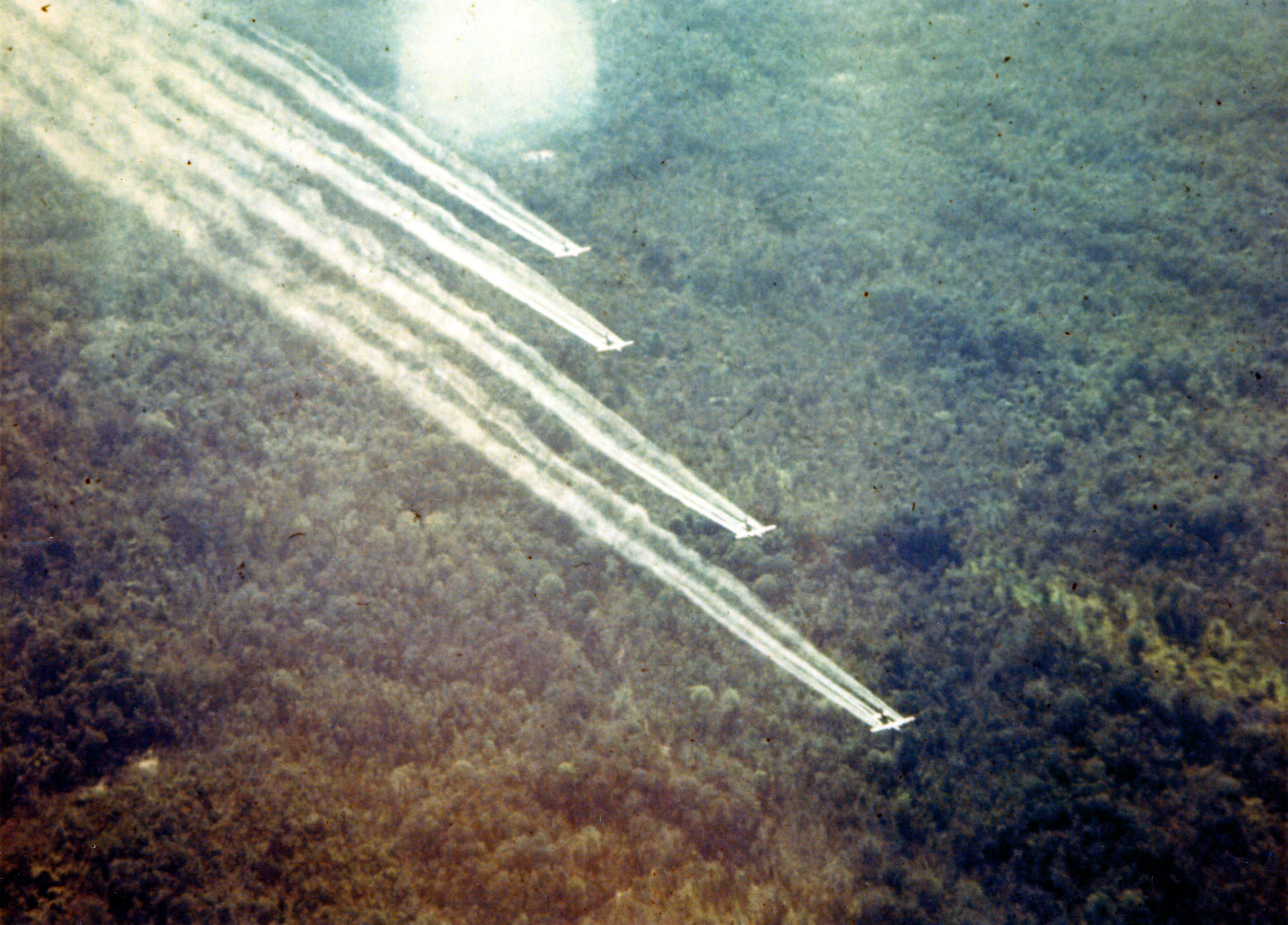
Operation Ranch Hand: US military planes spraying the jungle canopy and enemy food crops of Vietnam with Agent Orange, a chemical mixture containing the carcinogen dioxin, first used by the British army in the 1948-1960 war in Malaysia. This image shows a four-ship formation on a defoliation spray run. US Air Force photo via Wikimedia Commons.
Breaking news journalism
The camouflaging of death and the failure to report arms industry profiteering and the perils of ecocide warp our collective understanding of metaverse wars. So does government censorship, newspeak and threats of harassment and arrest, as when George W. Bush warned critics of the Iraq invasion that they would be treated as the fellow travellers of terrorism. Each trend shields us from war’s darkest horrors. But there is another factor driving the beautification of war: sensationalist, audience-seeking breaking news journalism.
In the era of metaverse wars, the genre of breaking news war reporting magnetises audiences and attracts advertisers, but at a great symbolic cost.
In high-risk war zones, helmeted and flak-jacketed journalists huddle together into clusterfucks (the word dates from the Vietnam War period). On terrain of which they have little direct knowledge, dependent upon interpreters because they have little or no grasp of local languages, they resort to hearsay and hype. Media celebrities like CNN’s Anderson Cooper parachute in to broadcast hastily selected ‘human interest’ stories befitting of their big name, big salary status. There are unending updates, but depth and context go missing in action. Cross-checking of the stories they are so eager to despatch becomes difficult.
For reasons of career advancement and reputational glory, they acquiesce in ‘script approval’, the practice whereby scripts in the field are checked and approved prior to recording by editors back at base. Reporters are also encouraged to join ‘pool systems’, first used in the 1991 Gulf War. They are instructed not to report the grisly or ghastly.
Things are not helped by the outsourcing of news. In their Ukraine war coverage, the BBC and many other mainstream Western media platforms put their trust in local ‘fixers’ and influencers, figures such as Orysia Khimiak, former director of a Ukraine PR firm named Reface, and in organisations such as the Kyiv-based Projector Institute, whose leading slogan is ‘Glory to Ukraine. We will win!’.
The upshot is that bad news doesn’t happen. Journalists become wartime ‘churnalists’, foot soldiers of mass deception, victims of a new kind of Stockholm syndrome in which journalism becomes the tame and willing public relations instrument of military strategies.
Civilian journalism
Given the grip of breaking news on mainstream media platforms, it is unsurprising that the age of metaverse wars has so far not produced brave and eccentric war journalists of the calibre of Martha Gellhorn, Robert Fisk, George Orwell, Ernie Pyle and Osip Mandelstam. But let’s pause.
Perhaps the time of the heroine lone ‘star’ war reporter skilled at challenging propaganda and stirring things up is over. For there is different breaking news: metaverse wars are beginning to democratise journalism. The ‘star’ contrarian journalists of the past are being replaced in their role as reality checkers by networked teams of humble, less-well-known civilian journalists who bravely file their on-the-ground reports to larger media platforms. The unfinished war that erupted over a decade ago in Syria arguably reset the compass. For the first time, civilian journalism began to make a difference.
It’s true that civilians reporting from the ground cannot end conflicts or bring about peace. They risk their lives but they don’t stop the killing or prevent the hellish destruction. Civilian journalists do something different.
Figures like Olga Tokariuk, Christopher Miller, Bellingcat founder Eliot Higgins, Oz Katerji and Bel Trew unpick the decadent effects of breaking news journalism. They function as gate watchers of the gatekeepers. They are ‘semiotic guerillas’ (Umberto Eco). They show and tell things frankly, from the ground up. They do all they can to ensure that war is mediated more democratically: more openly, less entertainingly, in more frighteningly down-to-earth ways.
Consider the global role played by the digitally connected Syrian search and rescue group known as the White Helmets (al-Ḫawdh al-baydaʾ), volunteers armed only with medical equipment and mobile phones. Or think of the work of the Syrian Observatory for Human Rights and the Violations Documentation Centre, monitoring groups that source their reports from civilians on the ground. It is thanks to them, not Fox News, Deutsche Welle, CBS News or the BBC, that we have a better sense of what this metaverse war has done to people and places.
The earthly hell thrust upon Syrians is terrifying. More than half of the pre-war population of 22 million forced to flee their homes. Massive aerial bombardments of densely populated areas. Entire neighbourhoods and cultural sites ruined. Barrel bombs. Chemical weapons attacks. Death by starvation in besieged cities. Nearly 7 million people living outside the country as refugees, or as stateless asylum seekers. Half a million deaths, most of them civilians. Tens of thousands tortured in government-run prisons. Beatings with metal rods, plastic pipes and electric cables. Flying carpets (sandwiching victims strapped face-up on foldable boards). Scalding with boiling water. Upside-down hangings with wrists tied behind the back. Amputation of prisoners’ body parts by trainee doctors using no anaesthetic. Genital mutilation. Rape. Slaughterhouse executions.
By reporting such horrors in undiluted form, civilian journalism contributes to the ‘denaturing’ of war. It does much more than put an end to war as media entertainment in censored form. War in all its ghastliness comes to be seen as contingent, as avoidable and even abolishable.
Here, to get our bearings, we need to turn to Michael Howard’s classic work The Invention of Peace (2000). It’s a fine account of the long-term significance of the early modern rejection of war as ‘natural’. Throughout history, he pointed out, most human societies have taken war for granted and made it the basis of their governing and social structures. Not until the 18th century in war-ravaged Europe did war come to be regarded as an unmitigated disaster, an evil that could be abolished by ‘enlightened’ social and political re-organisation. Only after the storms of steel and massive slaughter of two global wars did this precept become the declared objective of most territorial states. But as we know, and fear, war in one form or another continues unabated. We live in the age of nasty metaverse wars.
Can we jump over our own shadows? Is it possible to escape the hell of future Syrian- and Ukraine-style metaverse wars? We are forbidden from knowing the future, but as I first tried to explain in Reflections on Violence in 1995, the spirit and institutions of democracy can be used to accelerate the denaturing of war, for instance by issuing graphic warnings to rulers and ruled alike that war not only brings hell to earth, but that war is neither inexorable nor rooted in ‘human nature’.
Yes, the ill-fated US invasions of Afghanistan (2001) and Iraq (2003) showed that the language of democracy can be manipulated and debased by rulers bent on prosecuting wars. But when democracy is understood as public struggles by citizens and their chosen representatives to defend free and fair elections, and to expose and restrain secretive, arbitrary power, democracy can warn off the dogs of war.
Democracy can be used to democratise war. It can promote the circulation of unorthodox narratives and public condemnations of its cruelties. It can issue warnings about the potentially suicidal and ecocidal consequences of the shrinking gap between ‘nuclear’ and ‘conventional’ weapons such as hypersonic missiles and vacuum bombs. It can remind publics yet again that civilians – not armies or states – are today the real losers of battles.
Yet democracy can do more than destroy lies, satirise hubris, rupture silence and increase the public visibility of war’s awful violence. It can teach citizens that they have the right not to suffer metaverse wars – helping them to see that the active refusal of war combined with public awareness of the chronic failures of war to achieve its declared ends are together the best way of forcing powerful leaders hellbent on funding and fighting wars to concede that war in all its ugliness is after all unnecessary, and that in future war must be abolished.
An earlier version of this essay was published in Dutch in De Groene Amsterdammer and an excerpt appeared in the South China Morning Post.
Published 15 June 2022
Original in English
First published by De Groene Amsterdammer (in Dutch), South China Morning Post (excerpt in English), Eurozine (in English)
© John Keane / Eurozine
PDF/PRINTNewsletter
Subscribe to know what’s worth thinking about.
Related Articles
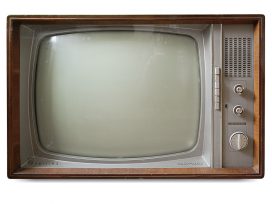
The days when Soviet citizens had only three or four TV channels to choose from are long gone. Today, Russians have hundreds of options. So why, asks Maxim Trudolyubov, do they still choose just one?




